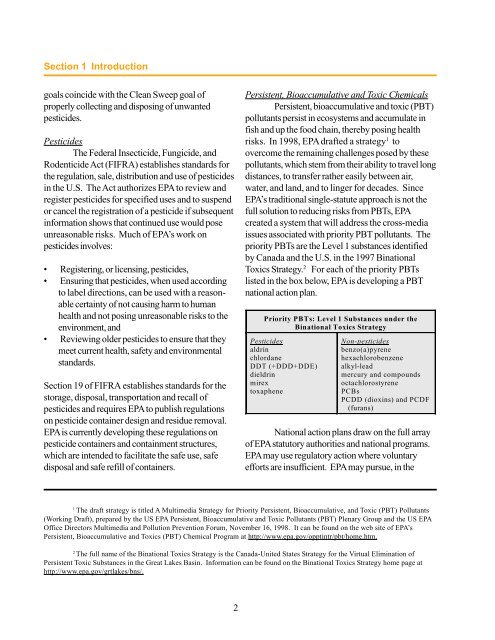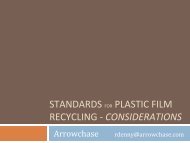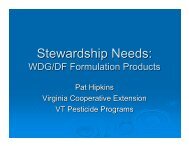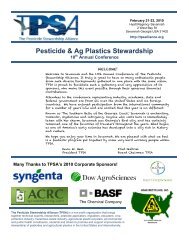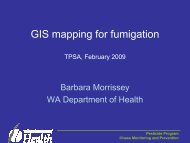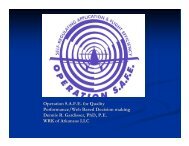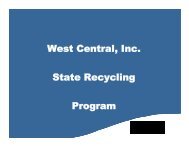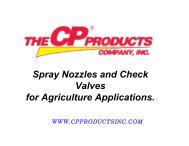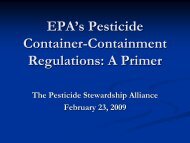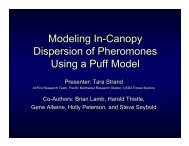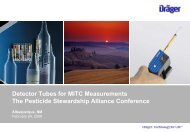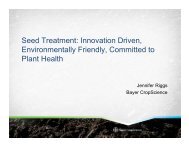Clean Sweep Programs - US Environmental Protection Agency
Clean Sweep Programs - US Environmental Protection Agency
Clean Sweep Programs - US Environmental Protection Agency
- No tags were found...
You also want an ePaper? Increase the reach of your titles
YUMPU automatically turns print PDFs into web optimized ePapers that Google loves.
Section 1 Introductiongoals coincide with the <strong>Clean</strong> <strong>Sweep</strong> goal ofproperly collecting and disposing of unwantedpesticides.PesticidesThe Federal Insecticide, Fungicide, andRodenticide Act (FIFRA) establishes standards forthe regulation, sale, distribution and use of pesticidesin the U.S. The Act authorizes EPA to review andregister pesticides for specified uses and to suspendor cancel the registration of a pesticide if subsequentinformation shows that continued use would poseunreasonable risks. Much of EPA’s work onpesticides involves:• Registering, or licensing, pesticides,• Ensuring that pesticides, when used accordingto label directions, can be used with a reasonablecertainty of not causing harm to humanhealth and not posing unreasonable risks to theenvironment, and• Reviewing older pesticides to ensure that theymeet current health, safety and environmentalstandards.Section 19 of FIFRA establishes standards for thestorage, disposal, transportation and recall ofpesticides and requires EPA to publish regulationson pesticide container design and residue removal.EPA is currently developing these regulations onpesticide containers and containment structures,which are intended to facilitate the safe use, safedisposal and safe refill of containers.Persistent, Bioaccumulative and Toxic ChemicalsPersistent, bioaccumulative and toxic (PBT)pollutants persist in ecosystems and accumulate infish and up the food chain, thereby posing healthrisks. In 1998, EPA drafted a strategy 1 toovercome the remaining challenges posed by thesepollutants, which stem from their ability to travel longdistances, to transfer rather easily between air,water, and land, and to linger for decades. SinceEPA’s traditional single-statute approach is not thefull solution to reducing risks from PBTs, EPAcreated a system that will address the cross-mediaissues associated with priority PBT pollutants. Thepriority PBTs are the Level 1 substances identifiedby Canada and the U.S. in the 1997 BinationalToxics Strategy. 2 For each of the priority PBTslisted in the box below, EPA is developing a PBTnational action plan.Priority PBTs: Level 1 Substances under theBinational Toxics StrategyPesticidesaldrinchlordaneDDT (+DDD+DD E)dieldrinmirextoxapheneNon-pesticidesbenzo(a)pyrenehexachlorobenzenealkyl-leadmercury and compoundsoctachlorostyrenePCBsPCDD (dioxins) and PCDF(furans)National action plans draw on the full arrayof EPA statutory authorities and national programs.EPA may use regulatory action where voluntaryefforts are insufficient. EPA may pursue, in the1The draft strategy is titled A Multimedia Strategy for Priority Persistent, Bioaccumulative, and Toxic (PBT) Pollutants(Working Draft), prepared by the <strong>US</strong> EPA Persistent, Bioaccumulative and Toxic Pollutants (PBT) Plenary Group and the <strong>US</strong> EPAOffice Directors Multimedia and Pollution Prevention Forum, November 16, 1998. It can be found on the web site of EPA’sPersistent, Bioaccumulative and Toxics (PBT) Chemical Program at http://www.epa.gov/opptintr/pbt/home.htm.2The full name of the Binational Toxics Strategy is the Canada-United States Strategy for the Virtual Elimination ofPersistent Toxic Substances in the Great Lakes Basin. Information can be found on the Binational Toxics Strategy home page athttp://www.epa.gov/grtlakes/bns/.2


